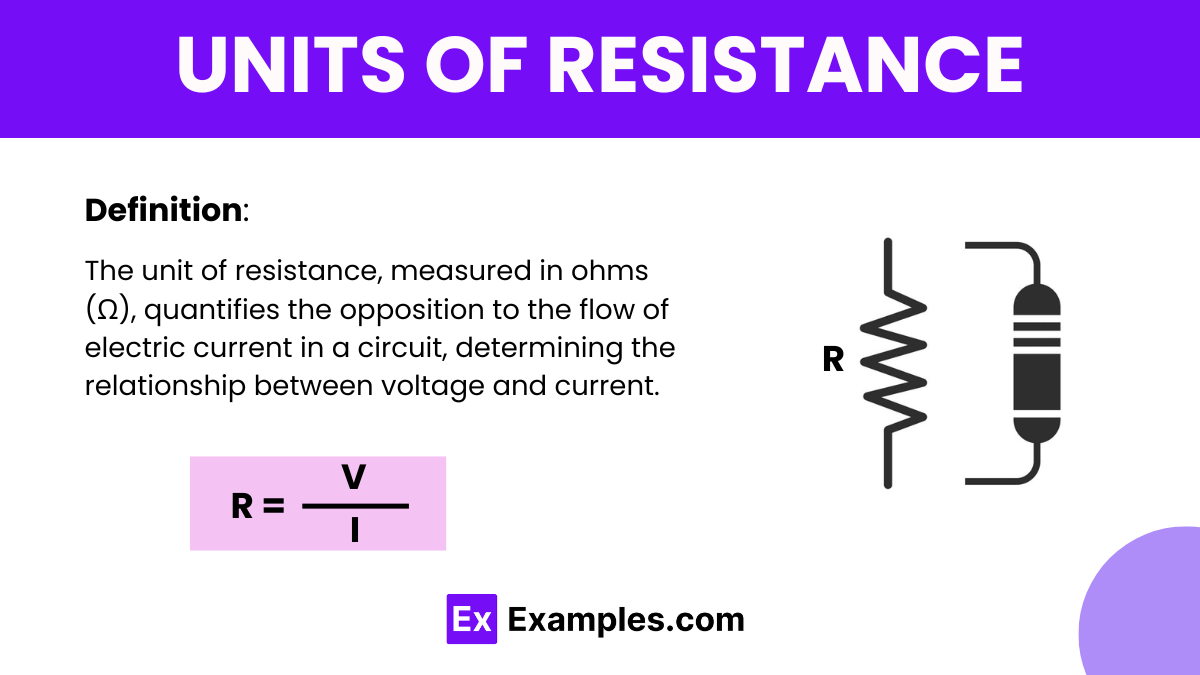What is the SI unit of electrical resistance?
Ampere
Volt
Ohm
Coulomb


Resistance, a fundamental concept in physics, is the measure of an object’s opposition to the flow of electric current. In electrical circuits, it is represented by the symbol R and measured in ohms (Ω). Understanding units of resistance is crucial in designing and analyzing electronic circuits, as well as in various engineering and scientific applications.
Where:
The SI unit of resistance is the ohm (Ω). It is named after the German physicist Georg Simon Ohm and is represented by the symbol Ω. In electrical circuits, resistance is measured in ohms and indicates the degree to which a material opposes the flow of electric current. The ohm is a fundamental unit in electrical engineering, electronics, and physics, and is used extensively in analyzing and designing circuits and electrical systems.
In the CGS (centimeter-gram-second) system, the unit of resistance is called the “abohm” (symbol: abΩ). One abohm is equivalent to 10⁹ ohms in the SI system. The CGS system is less commonly used in modern science and engineering compared to the SI system, but the abohm remains a part of historical context in some areas of study.
| Unit | Symbol | Equivalent to | Description |
|---|---|---|---|
| Kilohm (kΩ) | kΩ | 103 Ω | Equal to 1,000 ohms. |
| Megohm (MΩ) | MΩ | 106 Ω | Equal to 1,000,000 ohms. |
| Gigohm (GΩ) | GΩ | 109 Ω | Equal to 1,000,000,000 ohms. |
| Milliohm (mΩ) | mΩ | 10−3 Ω | Equal to 0.001 ohms. |
| Microohm (µΩ) | µΩ | 10−6 Ω | Equal to 0.000001 ohms. |
| To Unit | Conversion Factor | Example |
|---|---|---|
| Ohm (Ω) to Kilohm (kΩ) | 1 Ω = 10⁻³ kΩ | 10 Ω = 0.01 kΩ |
| Ohm (Ω) to Megohm (MΩ) | 1 Ω = 10⁻⁶ MΩ | 10 Ω = 0.00001 MΩ |
| Ohm (Ω) to Gigohm (GΩ) | 1 Ω = 10⁻⁹ GΩ | 10 Ω = 0.00000001 GΩ |
| Ohm (Ω) to Milliohm (mΩ) | 1 Ω = 10³ mΩ | 10 Ω = 10,000 mΩ |
| Ohm (Ω) to Microohm (μΩ) | 1 Ω = 10⁶ μΩ | 10 Ω = 10,000,000 μΩ |
Milliohms and microohms are important for measuring very low resistance values, such as those found in power electronics, electrical contacts, and high-current applications.
Different units of resistance provide flexibility in expressing resistance values across a wide range of scales, from small electronic components to high-voltage systems.
Resistance units are used in various electronic and electrical applications, such as designing circuits, calculating power dissipation, measuring sensor values, and determining the quality of conductive materials.
Text prompt
Add Tone
10 Examples of Public speaking
20 Examples of Gas lighting
What is the SI unit of electrical resistance?
Ampere
Volt
Ohm
Coulomb
Which symbol represents the unit of resistance?
Ω
V
A
W
What is the resistance of a conductor if the voltage is 10 volts and the current is 2 amperes?
5 ohms
10 ohms
20 ohms
2 ohms
If a resistor has a resistance of 10 ohms, what is the current through it when a voltage of 20 volts is applied?
1 ampere
2 amperes
5 amperes
10 amperes
Which of the following materials typically has the highest electrical resistance?
Copper
Aluminum
Silver
Rubber
What is the unit of conductance, the reciprocal of resistance?
Henry
Farad
Siemens
Tesla
How is resistance measured?
Using a voltmeter
Using an ammeter
Using an ohmmeter
Using a thermometer
What happens to the resistance of a conductor if its length is doubled?
It remains the same
It is halved
It is doubled
It becomes zero
If the cross-sectional area of a conductor is doubled, what happens to its resistance?
It remains the same
It is halved
It is doubled
It becomes zero
What unit is used to express resistivity?
Ohm per meter
Ohm per square meter
Ohm per cubic meter
Ohm-meter
Before you leave, take our quick quiz to enhance your learning!

